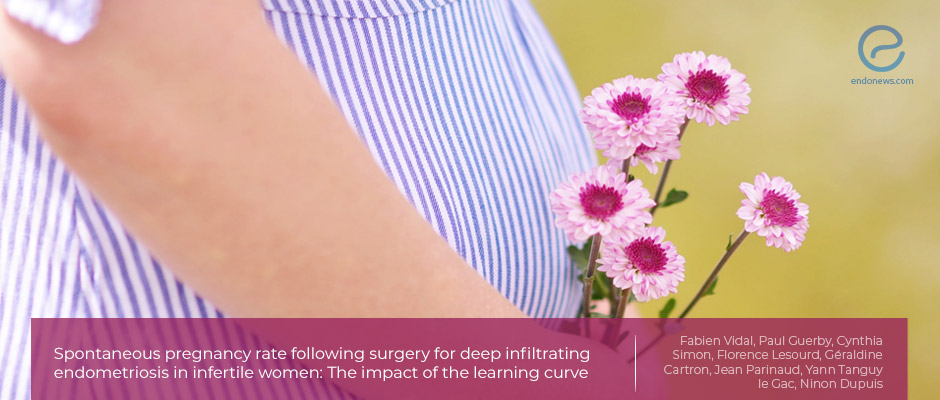Postoperative pregnancy rate in infertile women with deep infiltrating endometriosis
Jan 19, 2021
The spontaneous pregnancy rate in infertile women with deep infiltrating endometriosis who underwent operation varies depending on the curriculum of the surgeon rather than his experience.
Key Points
Highlights:
- The postoperative spontaneous pregnancy rate in infertile women with deep infiltrating endometriosis( DIE) depends on the stage of the disease, endometriosis fertility index (EFI) score, and body mass index.
Importance:
- Infertile women with deep infiltrating endometriosis wishing pregnancy after surgery should be counseled about the importance of surgery and predictors for spontaneous pregnancy.
What’s done here?
- Fifty infertile women who were operated on for DIE by the same surgeon at a single tertiary care center for 3 years were included in this retrospective study.
- The study population was divided into two groups as early (the first 25 cases) and late group (the 25 subsequent cases).
- Evaluation of the impact of the learning curve on spontaneous pregnancy rate following surgery was the primary outcome.
- Live birth rate (LBR) after spontaneous conception, overall pregnancy rate (spontaneous and ART), overall LBR, complication rate, clinical recurrence rate were secondary outcomes.
- During all operations, standard steps were performed regarding the evaluation of tubal patency, adnexal adhesiolysis, conventional ovarian cystectomy when applicable, identification of both ureters, the opening of pararectal spaces, identification of splanchnic nerves in case of parametrial extension, excision of all endometriotic lesions, and disease stage by ASRM.
- Conservative resection (shaving) or radical resection (segmental resection) were chosen depending on lesion size and location in case of bowel infiltration; partial cystectomy was performed for bladder infiltration.
Key results:
- There was no significant difference between the early and late groups in terms of demographic and clinical characteristics, except for age (older women in the late group).
- All patients underwent the laparoscopic procedure- blood loss was significantly decreased as the surgeon became more experienced.
- The surgeon’s learning curve had no impact on the rate of postoperative complications and clinical recurrence rate.
- Live birth rate after spontaneous conception, overall pregnancy rate including both spontaneous and assisted reproductive technology (ART) clinical pregnancies and overall LBR, postoperative complication rate, and clinical recurrence rate did not differ significantly between groups.
- Significant predictors for spontaneous pregnancy rate were ASRM stage, EFI score, and body mass index, rather than surgeon’s experience.
Strengths and Limitations:
- The major strength of this study was that the impact of surgeon’s learning curve on the postoperative spontaneous pregnancy rate in infertile women with DIE was specifically investigated.
- Retrospective design and non-randomization could be accepted as the weaknesses of the study.
Lay Summary
Deep infiltrating endometriosis (DIE) is fibrous/muscular infiltration of organs and anatomical structures containing endometrial tissue below the peritoneum regardless of the depth of infiltration. Another definition describes DIE as infiltration of the peritoneum by endometriotic lesions deeper than 5 mm. Pain, subfertility/infertility are the main clinical symptoms of these patients in whom surgical removal of all endometriotic lesions is required due to better outcomes in pain and fertility relief.
To investigate the impact of surgeon’s experience on postoperative spontaneous pregnancy rate, Vidal et al, from France, published a study titled “Spontaneous pregnancy rate following surgery for deep infiltrating endometriosis in infertile women: The impact of the learning curve” in the journal named "Journal of Gynecology Obstetrics and Human Reproduction".
The secondary objectives were to evaluate the association between surgeon’s learning curve and live birth rate (LBR) after spontaneous conception, overall pregnancy rate including both spontaneous and assisted reproductive technology (ART) clinical pregnancies and overall LBR, postoperative complication rate, and clinical recurrence rate.
The study included 50 infertile women with DIE who underwent operation by the same surgeon and assessed them in two groups as early and late groups. The patients did not show any significant difference in terms of their demographic and clinical characteristics, except for age.
The surgeon’s learning curve had no impact on the rate of postoperative complications and clinical recurrence rate. Live birth rate after spontaneous conception, overall pregnancy rate including both spontaneous and assisted reproductive technology (ART) clinical pregnancies and overall LBR, postoperative complication rate, and clinical recurrence rate also did not differ significantly between groups.
Significant predictors for spontaneous pregnancy rate were ASRM stage, EFI score, and body mass index, rather than surgeon’s experience. “Surgeon’s curriculum is probably more important than the crude number of past procedures she/he has actually performed.” the authors added.
Research Source: https://pubmed.ncbi.nlm.nih.gov/33049364/
deep infiltrating endometriosis surgery learning curve fertility spontaneous pregnancy

